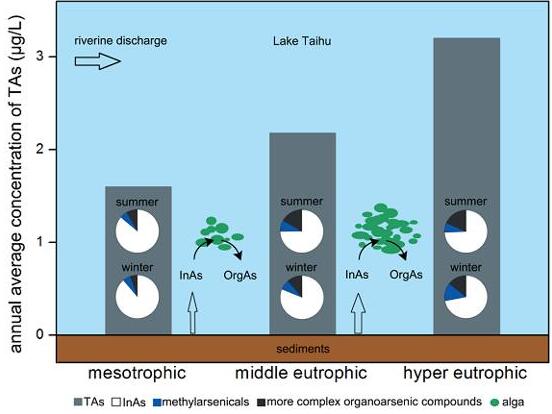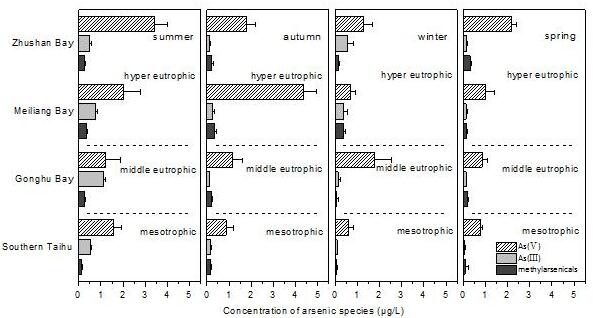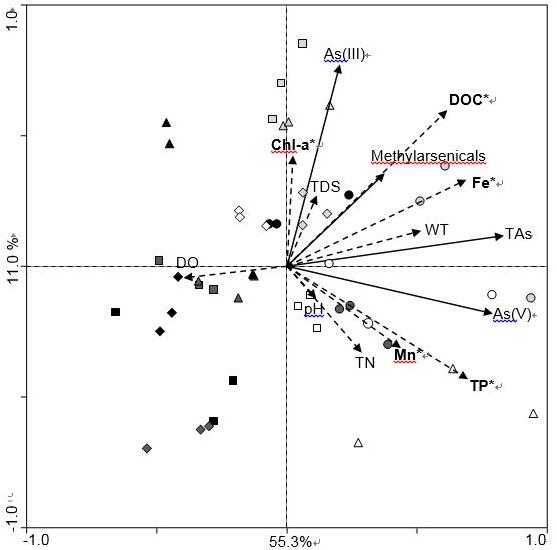Arsenic in natural aquatic systems mainly exists in inorganic states including arsenate (As(V)) and arsenite (As(III)) and organoarsenicals including monomethylarsenic acid (MMA(V)) and dimethylarsenic acid (DMA(V)). It has attracted extensive concern, because of its potential environmental risk to human health. Although previous researche have indicated that eutrophication may play an important role in the transport and transformation of As in aquatic environment., However, until now, there is little systematic research. Especially locating research observation based on long term and multivariate statistical analysis of the environmental impact factors is still lacking and lagging.
Urban aquatic environment and ecology research group(Changzhou Yan’s research team), Institute of Urban Environment, Chinese Academy of Sciences, selected different eutrophication waters (including Zhushan Bay, Meiliang Bay, Gonghuv Bay, and Southern Taihu) according to the human activity intensity gradient and established long-term ecological environment observatory in the Lake taihu basin from 2012. They focused on systematacially researching for spatial and seasonal variations of arsenic species in form of water and sedimentary phase and the related physical and chemical parameters of water system, etc. Through the data for years analysis shows that relatively high levels of total arsenic (TAs) and arsenate (As(V)) were observed in hyper-eutrophic regions during summer and autumn. The distributions of TAs and As(V) were significantly affected by total phosphorus, iron, manganese, and dissolved organic carbon. Arsenite (As(III)) and methylarsenicals ((MMA(V)+(DMA(V)) exhibited significantly higher concentrations and proportions(proportions of (TAs)) in hyper-eutrophic and middle eutrophic regions during summer compared to mesotrophic region. Further analysis found, the eutrophic environment, which induces changes in the main water quality parameters such as phosphorus, chlorophyll-a, iron, manganese, and dissolved organic carbon, can favor the biogeochemical cycling of arsenic in the aquatic systems. Due to the many areas in China is not only facing with heavy metals and arsenic pollution, at the same time but also bearing the eutrophication of water bodies, therefore this study is vital significant to deeply understand the environmental geochemical behavior of arsenic in the environment of eutrophic lakes, predict its ecological risks and protect lake ecosystem health and the safety of drinking water source.
The result of the study is published in the international journal of environmental science. Science of the Total Environment, 2016, 563/564: 496–505 (Changzhou Yan, Feifei Che, Liqing Zeng, Zaosheng Wang, Miaomiao Du, Qunshan Wei, Zhenhong Wang, DapengWang, Zhuo Zhen. Spatial and seasonal changes of arsenic species in Lake Taihu in relation to eutrophication). This study was funded by the National Nature Science Foundation of China and International Science & TechnologyCooperation Program of China.
http://www.sciencedirect.com/science/article/pii/S0048969716308257

The conceptual model diagram of how eutrophication influence arsenic distribution in lakes.

The seasonal distribution of arsenic species in different eutrophication of waters of Lake Taihu.

Redundancy analysis (RDA) ordination showing the distribution of TAs and As speciation (As(V), As(III),and methylarsenicals) in relation to the main water quality parameters.